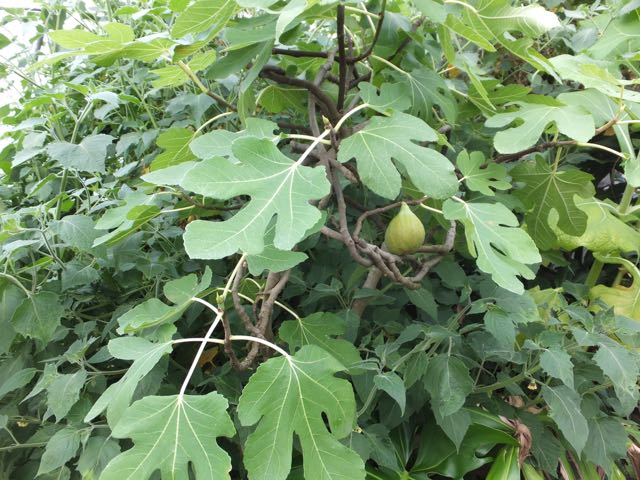
Figs really are the most curious of glasshouse fruits. These are very ancient crops developed from the wild form in western Asia where these were pollinated by a tiny Chalcid wasp that evolved to depend on the fig and vice versa. The way these wasps interact with the flowers, which are tiny and hidden inside the unripe fruits, is incredible. (See appended article for numerous details.) Fortunately in the UK we have dozens of fig varieties that set fruit without any such pollination. And because our figs are ‘parthenocarpic’ this also makes them seedless and are the more luscious for it.
Although almost sub-tropical in origin, figs are also one of the easiest glasshouse fruits to grow, that is if you grow them in tubs. Planted in the border, or worse, the open ground figs can become huge, massive, multi-stemmed trees. Confine their roots and instead these remain compact attractive foliage shrubs, ones that also bear sweet fruits. A tub constricts figs so these do not need much pruning unless overfed and they then fruit more regularly, indeed too easily and too often.
Figs are easy to grow and not picky as to compost or watering regime, seldom require much feeding and very rarely have any pest or disease problems. You could grow a fig from seed but that will produce a throwback ‘wilder’ sort and take decades and with many dozens of varieties sold at modest prices for already fruiting specimens it’s sensible to buy. Brown Turkey and Brunswick are reliable though there’s many others with yellow, red, black or violet tinted fruits.
Now I said figs were curious. They are deciduous but given warmth and light can stay evergreen, and more than that, with their hot climate ancestry figs try to set three crops of fruit a year. Now some centuries ago a French gardener de la Quintayne did manage to ripen all three crops a year but this required immense labour, manipulation and heat. It’s simpler to aim for one good crop during summer when it’s hot enough to ripen really sweet fruits.
Growing for one good crop means the tubs go outdoors from late autumn till late winter freeing up space under cover. The exposure to hard weather cleans the plants of pests and in mid winter you remove every figlet no matter how small. In spring thin hard those figlets that start leaving just the best to swell really huge and sweet. After you taste your first home grown fresh fig you’ll be wanting more varieties, and a bigger greenhouse.
Extract from my E-book – ‘Really help your garden ecology’:
In the UK we have varieties that produce ripe figs without pollination and which are therefore seedless. However original wild fig trees as in Mediterranean and Bible needed the aid of a small Chalcid wasp, these trees produce four types of flower, male, female, dummy female and gall-flowers in three batches of figs. (The spring dummy female bearing figs have sterile female flowers and may ripen into inferior seedless fruits.) The male flower bearing figs swell at the same time in early spring, a hole in the end lets in female wasps which lay eggs in the gall flowers deep inside, the brood hatches, males first which fertilise the females then die, the females leave through the hole which is now lined by pollen bearing male flowers. They have wings and fly to the next batch of summer swelling figs whose holes allow them in, inside are only normal female flowers which are shaped to prevent the wasps laying eggs. However the wasps pollinate these figs in the process. The third or autumn batch of figs then swell, their holes open and allow female wasps in where they find only gall-flowers in which they can lay their eggs. These autumn figs house and feed the gall wasps which then emerge in spring to start the cycle again.
Years of cultivation has now produced varieties which have developed all female fruit bearing trees and separate goat-fig trees which carry the male and gall-flowers. The first figs to swell are dummy female ones on the fruit bearing trees which seldom come to much and figs on the goat fig trees which have male and gall-flowers and are laid in by the over-wintered wasps emerging form the old gall-flower figs. The new eggs and larvae grow then pupate and emerge in time for the summer swelling figs, which are all normal females on the fruit bearing trees, these get pollinated and make the most important crop. Then in autumn the third batch of figs swell, normal flowering ones on the fruit bearers and gall-flower ones on the goat-fig trees. The normal ones get pollinated and make a second crop, the gall-flowers receive the eggs and over-winter a brood for the next year.
But as I said at the beginning in the UK and most cooler countries we cultivate varieties that ripen fruits without pollination and thus also without seeds.


